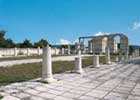 |
Pliska |
 |
 Pliska used to be the main political, military, economic and cultural centre from the foundation of the Bulgarian State in 681 till 893. The town is also among the most impressive monuments of Medieval European town-planning. Situated at a crossroad amidst a vast plain of rolling hills, the first capital of the Bulgarian State was protected with strong fortress walls.
Pliska used to be the main political, military, economic and cultural centre from the foundation of the Bulgarian State in 681 till 893. The town is also among the most impressive monuments of Medieval European town-planning. Situated at a crossroad amidst a vast plain of rolling hills, the first capital of the Bulgarian State was protected with strong fortress walls.
Researchers have found three stages in the development of the ancient Bulgarian capital. Khan Kroum’s Palace was built on an area of 500 square metres and is a remarkable architectural monument of the first stage. The second stage marked the peak of town design and construction. That was the time when Khan Omourtag ruled. Dating back to that period are the fortress walls, the so-called Small Palace with houses for the members of the royal family, the new baths with an intricate heating system, two pagan shrines and the richly decorated Throne Hall. The third construction stage includes early Christian buildings of worship with impressive size. The most impressive architectural monument of that time is the Grand Basilica. With its 2920 square metres it was the largest Christian church on the Balkan Peninsula for its time. The imposing three-nave basilica was 100 metres long and 30 metres wide. It was in the centre of a monastery complex of sophisticated architecture.
Pliska is the town where the Christian faith was adopted as an official religion of the Bulgarian people in the 9th century. In the year 886 Prince Boris I received here the disciples of the creators of the Slav Alphabet the brothers Cyril and Methodius.
|

 Last Issue
Last Issue

 Subscribe NOW!
Subscribe NOW!
 Български
Български

 Pliska used to be the main political, military, economic and cultural centre from the foundation of the Bulgarian State in 681 till 893. The town is also among the most impressive monuments of Medieval European town-planning. Situated at a crossroad amidst a vast plain of rolling hills, the first capital of the Bulgarian State was protected with strong fortress walls.
Pliska used to be the main political, military, economic and cultural centre from the foundation of the Bulgarian State in 681 till 893. The town is also among the most impressive monuments of Medieval European town-planning. Situated at a crossroad amidst a vast plain of rolling hills, the first capital of the Bulgarian State was protected with strong fortress walls.